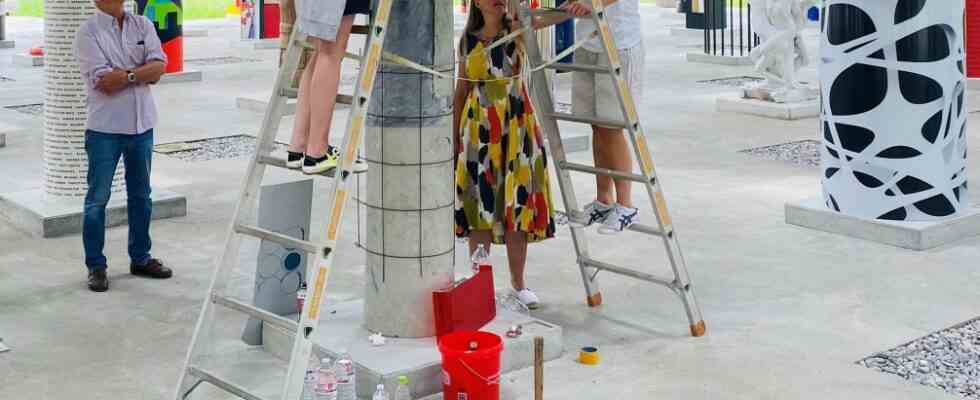The pillar is not as perfect as the neighboring stelae. It doesn’t shine or flaunt, it has nothing bombastic about it. But it tells the story of a country that has learned to cope with shortages and makeshift arrangements. Sheet metal parts screwed together, in between leftover wallpaper, pieces of plastic or scraps of fabric, decorated with stylized roses. The new addition to the Pollinger columned hall “Stoa 169” comes from Georgia and occupies one of the spaces in the middle diagonal that Stoa initiator Bernd Zimmer intended for international art academies.
The first pillar in this series comes from the Munich Academy, the second from Vienna. Gabriela von Habsburg, a sculptor and professor at the Art Academy in Tbilisi since 2001, had suggested that Zimmer give one of the places to her students. When Zimmer traveled to the Georgian capital at the end of the semester in July to view the work, the students presented him with 16 proposals that illuminated the topic of the stele from all sides and from many aspects. “Everyone had designed their own column,” reports Zimmer. Surprised by the high quality, it was difficult for him to make a choice.
Roses commemorate the 2003 revolution
Pillars are of great importance in Georgian history, says Habsburg, who accompanied her students to Polling. In earlier times, the “mother pillar” protected people who sought refuge in caves. “Of course it’s great for our students to be able to create a lasting work of art,” she says. “We don’t often get that opportunity.” Of course, the students knew from the beginning that only group work could be realized in polling. Tina Janiashvili, Mariam Mestvirihvili, Teimuraz Eristavi and Vato Bakradze eventually formed the team that traveled to Polling to design the common pillar there. On this August afternoon, they are in the process of putting the finishing touches on the column. They found some of the materials for this on the street or on construction sites, and some bought them at street markets, says Teimuraz. The stylized roses can be found everywhere in Georgia, says Tina, the decorative motif is a must in its kitschyness, Mariam adds. The young people do not mention that it is also reminiscent of the Rose Revolution of 2003. There is great joy in having their work stand alongside that of very famous colleagues. “It’s the first time we’ve done something like this,” says Vato, enthusing about the great opportunity to be able to implement an idea together.
Thorsten Fuhrmann, an artist from Huglfing, has set up a temporary installation very close to the Georgian column: an aluminum ladder that, placed in a gravel field, protrudes through a light opening over the roof. “I wanted to visualize the connection from bottom to top,” says Fuhrmann, who feels part of the Fluxus art movement. The work of art is not the focus, but the aim is to raise public awareness and experience a new reality, in this case a mental or emotional ascent into the open air, into heaven.
Column hall Stoa 169, open all day. donation instead of admission, polling Info below www.stoa169.com

